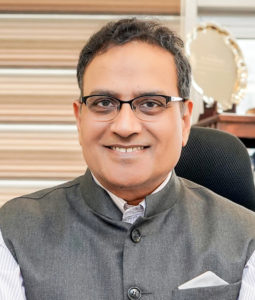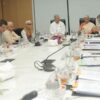Security and privacy are built into the design and development of the APIs:

Dr.Indu-Bhushan
Prime Minister Narendra Modi had announced the National Digital Health Mission (NDHM) during his Independence Day address to the nation. Dr. Indu Bhushan, Chief Executive Officer, Ayushman Bharat, Pradhan Mantri Jan Arogya Yojana (AB – PMJAY), National Health Authority (NHA), shares details about this flagship initiative.
Mehul Dani: What is the role of NDHM? What will be its scope and ambit?
Dr. Indu Bhushan: NDHM aims to develop a digital health ecosystem in India and enable the creation of a secure public digital infrastructure for the healthcare sector. It intends to empower healthcare providers and health facilities through digital registries and facilitate electronic signatures to make paperless registrations and payments. It will provide opportunities to deploy systems to streamline healthcare information. It aims to connect the entire health ecosystem of India through a reliable and secure digital backbone. NDHM will implement key digital building blocks detailed in the National Digital Health Blueprint and make them accessible as digital public goods to the public as well as the private sector. The building blocks will be available as a collection of cloud-based services. Together these will create a robust framework to enable better healthcare delivery and management for the country.
By when it will be operational? How will it be made functional?
Currently, NDHM is being piloted in 6 union territories – Andaman & Nicobar Islands, Chandigarh, Ladakh, Lakshadweep, Puducherry and Dadra, Nagar Haveli, Daman & Diu. The rollout is focused on 3 building blocks – creation/issuance of Health ID for individuals, enrolling doctors on Digidoctor and registering public and private sector health facilities, labs, clinics in the Health Facility Registry. We are also launching a Personal Health Records (PHR) app at the individual level and Electronic Medical Records (EMR) web app to ensure interoperability in the system. The building blocks currently being deployed in the 6 UTs will be rolled out nationwide after learning from the experience of the pilot.
Who will be the major constituents, stakeholders of NDHM?
NDHM will support the entire health system. The key stakeholders are our citizens. By design, NDHM is citizen-centric. Its building blocks are designed to ensure that an individual’s privacy is maintained. The other stakeholders are healthcare professionals, public health researchers, healthcare facilities (private & public), labs, and clinics. Different types of licensing and certification authorities are poised to play a key role in the ecosystem. Insurance companies, audit firms, and health technology provider companies will be crucial along with other stakeholders to enable the development of a vibrant and self-sustaining ecosystem.
How will a health ID be created? How will the privacy and safety of digital health ID be ensured?
Health IDs can be created by providing basic information that includes full name, year of birth, gender, and either a mobile or an Aadhaar number. Most people with smartphones or access to the internet and computer are expected to self-enrol and create their Health ID through https://healthid.ndhm.gov.in.
Healthcare providers can assist patients in creating Health IDs. This is especially required in the case of the elderly and digitally challenged. Every Health ID must be created only after educating the patient regarding the benefits of the Health ID and obtaining the explicit consent of the patient. Other avenues for creating Health ID will also be explored to increase its reach. Security and privacy are built into the design and development of the APIs.
Will the IT and digital mechanisms be developed in-house or outsourced under NDHM?
Health ID, Digi-Doctor, and Health Facility Registry form the core building blocks of NDHM. While these platforms will be owned and managed by the Government of India, the data will be solely owned by the entity registering these registries. NDHM is responsible for the design and deployment of these building blocks and will maintain end-to-end ownership on these platforms. NDHM has ensured that these platforms comply with all applicable laws and regulations. The actual application will be developed in partnership with the private sector under NHA’s supervision.
We are also introducing a sandbox for all stakeholders, including the private sector, to collaborate on the technology products being built on the pre-condition that they must be compliant with prescribed privacy and security guidelines.
Will there be any cap on the expenses incurred by patients for any treatment? How is dispute resolution going to be structured under NDHM?
NDHM’s goal is to provide a digital ecosystem to improve the quality and access of healthcare delivery by empowering a patient through digital means. The scope of the mission is to ensure international standards and that the interoperability between the various building blocks is attained. The standardization of prices and expenses is not under its ambit. The digital ecosystem will enable a proper consent mechanism for data shared by the patient to the provider. The activities will leave behind a transparent audit -trail that may help in minimizing situations of dispute.
What are the latest updates in Ayushman Bharat – Pradhan Mantri Jan Arogya Yojana (PM-JAY)?
Ayushman Bharat-Pradhan Mantri Jan Arogya Yojana (AB PM-JAY) was approved on 21 March 2018 and was launched on 23 September 2018. The scheme was operationalized, including a robust, scalable, interoperable IT system, from scratch in 6 months. The initial momentum of the scheme has been encouraging with 32 States/UTs implementing it. More than 125 million e-cards have been distributed (including state cards) with close to 12 million hospital admissions worth Rs153.45 billion taking place through a network of 23,200+ impaneled hospitals (45% private).
The IT system has been strengthened further to ensure that the services remain paperless and cashless for the beneficiaries through the end-to-end online tracking. It has many blocks depending on the entire chain of service delivery in the mission. The 3 main components of service delivery are:- Hospital Empanelment Module (HEM): Hospitals interested to partner with AB PM-JAY, can apply online through this module and their applications are scrutinized and approved the online module enabling transparency and accountability.
– Beneficiary Identification System (BIS): BIS system has been developed to identify and verify the beneficiaries at CSCs and points of care. Hospital Transaction Management System (HTMS): A comprehensive TMS system has been developed to facilitate transactions from hospitals (such as filing pre-authorization requests and claims submission).
The IT system is being strengthened to create a national health claims platform as part of the IT 2.0 initiative. We intend to put in place a digital health claims management platform. PM-JAY will also develop standards and protocols for claims management processes in collaboration with the Insurance Regulatory and Development Authority of India (IRDAI). The claims management platform will be made available to other schemes and private insurance companies and hospitals for use on a voluntary basis. This will ensure that there will be no duplication and beneficiaries can be tracked across different schemes.
The creation of the Health Benefits Package (HBP) has led to the standardization of definitions of packages and their inclusions across all the 32 states/UTs where the scheme is being implemented. About 130,000 hospital admissions worth Rs2.78 billion have taken place taking advantage of portability.
What is the fraud and abuse control mechanism in place?
Special units at national and state levels have been set up as part of a strong mechanism to detect, prevent, and deter fraud and misuse. NHA is using advanced data analytics in this exercise and has proposed the use of AI/ML. Through the measures taken on the basis of data analytics and field investigations, more than 200 hospitals have been de-impaneled, and more than 10 FIRs have been registered so far.
How do you view innovations in the healthcare system?
In a bid to encourage innovations around enhancing access to affordable quality healthcare, NHA has set up a National Innovation Unit. A Startup Grand Challenge was launched by the Prime Minister on 1 October 2019 to source the most innovative solutions to 7 identified implementation challenges of AB PM-JAY and to identify, recognize and reward the best health-tech startups in the country and to help mainstream top-notch innovations into the Indian health system. Out of hundreds of applications by startups, 49 made a pitch to a jury of 10 senior experts from medicine, public health, investment and business, and technology at the semi-final stage. Of these, 22 have been selected for the finals.
NHA has been supporting the Government of India’s response to covid. It has been also supporting the management of the national covid helpline (1075) through its call center. As on 10 August over 3.748 million calls have been answered by the call center and team and on a daily basis we are answering around 10,000 calls.
NHA has collaborated with Arogya Setu in order to strengthen the usage of the application and provide more teleconsultation support to citizens. The calling was started on 23 April and got completed on 28 June. During the project, NHA has made over 2 million calls and provided doctor consultations to approximately 50,000 citizens.







